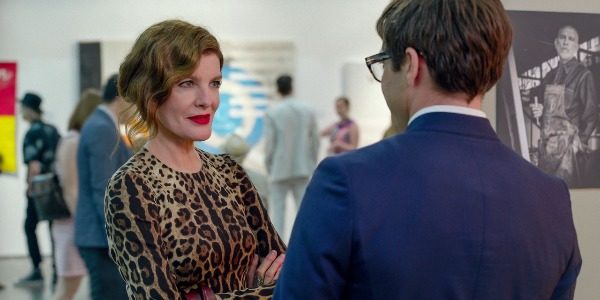VELVET BUZZSAW: Final Destination Transported To The World of Art

Alistair is a 25 year old writer based in Cambridge.…
Dan Gilroy is clearly a student of the 70’s New Hollywood era, with his filmography prior to his latest effort laying bare a deep appreciation for the American films of this period. But this has also worked to his detriment, because as enjoyable as his previous directorial efforts were, they didn’t offer anything particularly novel that you couldn’t already get in the films they were influenced by. Nightcrawler is just a retread of Sidney Lumet’s Network with a newly applied Fincher-esque sheen, while his divisive sophomore effort Roman J. Israel. Esq was an offbeat attempt at marrying a similarly Lumet-inspired legal thriller with something approaching a Hal Ashby quirk.
His third film, Velvet Buzzsaw, is a significant departure from his previous work; a messy, satirical horror that doesn’t have any clear precedent within the 70’s, Gilroy’s hitherto favoured decade of influence. It’s refreshing to see him stray from his comfort zone in this manner, but unfortunately, his lack of experience within the horror genre is all but apparent; he may be a talented director, but when it comes to building tension and crafting creepy sequences, it’s very clear this is the product of a novice. Mercifully, this isn’t an “elevated horror” that takes itself too seriously and acts like its above the genre it’s a part of. The problem with Velvet Buzzsaw is that it’s made by a person who may sincerely appreciate horror at its campiest, but doesn’t know how to make it effective beyond the kitsch.
Where Art Meets Trash
Jake Gyllenhaal stars as the fabulously named art critic Morf Vandewalt. Going through a breakup with his boyfriend, he finds solace in gallery worker Josephine (Zawe Ashton), entering her life just as she discovers a dead neighbour in her apartment block, with boxes of previously undiscovered paintings. Soon, her gallery owner Rhodora (Rene Russo), a former singer with the punk band that gives the film its name, discovers the paintings and makes them the talk of the town. As the paintings, by an undiscovered artist known as “Deese”, grow in critical popularity, Morf’s obsession with them uncovers something deeper – a tragic backstory in the artist’s life, that creates a lingering threat for those who continue to profit from works the artist demanded be destroyed.

Critics have fallen over themselves in a race to see who can compare it to Tom Ford’s Nocturnal Animals the first. It’s a fairly lazy, surface level comparison – both are thrillers set within the art world, that happen to star Gyllenhaal and Ashton. But if you were to take this train of thought further (and as it’s been lazily humoured by so many, why not run with it?), the shortcomings of Velvet Buzzsaw are more apparent in comparison. Tom Ford, after all, is one of the most famous figures in the fashion world, and it takes somebody with a pioneering fashion sense to make something equidistant between art and trash with the precision it needs, marrying (in his case) a disparate relationship drama with a tense murder mystery in the deep south.
Gilroy, to his credit, has an even more daunting task: trying to make a satire about the insular ridiculousness of the art world feel of a piece with a high concept horror. In terms of ascertaining the influence of the former element, he’s spoken at length about being inspired by entertainment industry ensemble pieces in the same vein as Robert Altman’s The Player. But there isn’t a particularly clear influence on the horror aspect, which is why comparisons to Nocturnal Animals are the easiest to reach for despite very little formal similarities.
In fact, the horror films Buzzsaw resembles in the moments it does succumb to the genre are the Final Destination series. It’s hard to tell how intentional this is; the art satire is played for wry laughs, but considering the lack of tension to the different supernatural attacks and the silliness to many of the different kills, each deadly occurrence provokes blackly comic laughter due to sheer goofiness.
Horror or Pure Hilarity?
It’s an awkward tonal balance to pull off, and Gilroy squanders here. I was left thinking about Peter Strickland’s In Fabric, to be released later this year following a successful festival run, and how it manages to be appropriately discomforting despite its tongue in cheek, giallo pastiching silliness – in that case, a haunted dress as opposed to haunted paintings. The only explanation as to why that film could be more effective is due to wearing its trashy genre influences nakedly on its sleeve. This is the first time Gilroy’s influences haven’t been apparent, and as a result, the horror moments feel broad and ill-fitting to a hyper specific satire around them.

Of course, it would be easy to blame the horror side of the narrative for being solely responsible for the film’s issues. But despite having its eyes firmly on its intended satirical target elsewhere, it still falls apart due to the unnecessarily extensive ensemble cast. When actors of the calibre of John Malkovich, Toni Colette and Daveed Diggs are awkwardly on the perimeters of the story, offering nothing to further the tension or satirical thesis on the art world outside of succumbing to various manias the central trio have been exposed to in some way, it’s a clear sign the film would be more effective were it to take a streamlined approach to storytelling. Gilroy’s only prior screenwriting credit with a foot in the horror world is, bizarrely, a co-writing credit on 2017’s Kong: Skull Island – coincidentally, another effort where the monstrous threat is significantly lessened by a (in that case, tedious) ensemble comedy occurring around it.
Gilroy’s lack of experience in crafting horror narratives also leads to the faux pas of overly explaining the supernatural occurrences the audience can expect, long before the film has entered macabre territory. Gyllenhaal’s art dealer conducts excessive research about the artist behind these mysterious paintings – and as a result, we get bombarded with context that all but maps out the direction of the story before ghoulish occurrences begin. The film would still be hilarious without this due to the nonsensical, Final Destination style attacks and deaths that follow, but explaining the threat before it’s even manifested in this manner drains any expectation of tension as the film progresses.
Velvet Buzzsaw: Conclusion
It’s easy to be critical of Velvet Buzzsaw, but although the film isn’t successful, I appreciate Gilroy firmly stepping out of his comfort zone to try something new. As a satire, its thesis is too obvious to be truly biting, and as a horror, it’s too ridiculous to be scary – instead, it’s a whole host of ideas and genre inflections thrown at the wall to see if any of them stick, or at least form something remotely coherent.
It’s an ambitious gamble that didn’t pay off, but it has reinvigorated my interest in Gilroy as a filmmaker. If he’s willing to experiment like this, it’d be a shame if he returned back into his crime drama wheelhouse for his next effort.
Which high concept horrors have managed to scare you, despite silly premises?
Velvet Buzzsaw is now streaming around the world on Netflix.
Does content like this matter to you?
Become a Member and support film journalism. Unlock access to all of Film Inquiry`s great articles. Join a community of like-minded readers who are passionate about cinema - get access to our private members Network, give back to independent filmmakers, and more.
Alistair is a 25 year old writer based in Cambridge. He has been writing about film since the start of 2014, and in addition to Film Inquiry, regularly contributes to Gay Essential and The Digital Fix, with additional bylines in Film Stories, the BFI and Vague Visages. Because of his work for Film Inquiry, he is a recognised member of GALECA, the Gay & Lesbian Entertainment Critics' Association.













